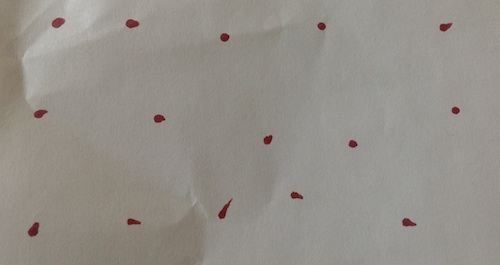The New York Times published an article about Common Core homework this week.
As is going to be the case with a news article (in contrast to say, a post on a blog dedicated to children’s mathematical ideas), one can’t really learn any mathematics from the piece. One critique got hit twice, though—that children are being forced to draw lots of dots.
Here near the beginning of the piece:
Ms. Nelams said she did not recognize the approaches her children, ages 7 to 10, were being asked to use on math work sheets. They were frustrated by the pictures, dots and sheer number of steps needed to solve some problems.
And a bit later:
Her daughter, Anna Grace, 9, said she grew frustrated “having to draw all those little tiny dots.”
“Sometimes I had to draw 42 or 32 little dots, sometimes more.”
I have no interest in picking up political issues surrounding the Common Core State Standards on this blog.
But I do think a parent frustrated by all those dots deserves an explanation of what all those dots are for.
Before we begin, please be assured that there is absolutely no mention of dots in the Common Core. What is mentioned is the array. An array is a collection of things arranged in rows and columns. We have discussed arrays before here at Talking Math with Your Kids. They are very useful tools for representing an important meaning of multiplication—that multiplication is about some number of same sized-groups.
Arrays (with dots or other things) are useful tools for making these groups visible, either actually visible or visible in the mind.
So I asked Tabitha (7 years old) to draw some dots for me.
—
Me: Tabitha, [neighbor girl and best friend] wants to play. Before you go outside, can you draw that picture for me? Three rows of five dots.
Tabitha (7 years old): That’s easy! Fifteen.
She is probably counting by fives here. She completes her picture for me.
I know that neighbor girl is waiting. I decide to press my luck.
Me: What if it had been 3 rows of 6?
There is a long, thoughtful pause.
T: Eighteen!
Me: How did you know that?
She shrugs her shoulders. Now is not the time to force things. Neighbor girl is waiting. So I offer a strategy.
Me: Let me tell you how I think you might know it.
T: OK.
Me: Six is one more than five. So each row would have an extra dot. That’s 15 for the 3 rows of 5, and then 16, 17, 18.
T: [smiles] Yeah.
We share a high five and she is out the door for a morning of clubhouse shenanigans in the backyard.
Quick note: Tabitha does not let me get away with stating her strategies incorrectly. I have done this before—summarized how I think she is thinking—and when I get it wrong, she objects. I am glad about this.
So what do we learn?
This is what those dots are for. They give us something we can talk about. Without those rows and columns, the conversation is so much more abstract. We were picturing those dots in our minds as we talked about counting them.
The three rows of five she drew gave us a jumping off point for imagining the three rows of six we discussed. Three groups of five now has a relationship for her to three groups of six.
More importantly, the strategy of finding new facts based on old facts (here that 3 groups of 6 is 18 based on knowing that 3 groups of 5 is 15), has been introduced explicitly. It is something we will talk about in the future, and something she will know to consider.
Without the array, it is not at all clear to me that she would have been able to know what 3 groups of 6 is. She could have drawn 3 unorganized groups of 6, I suppose, and counted them individually. But this is a much less sophisticated strategy, and she is ready for more than counting individual objects.
Starting the conversation
Many children do not naturally see rows and columns. Given an array, they may haphazardly count the objects around the edge, then in the middle. This often leads to double counting and skipping things.
But even children who are very good at keeping track of their haphazard counting—and who can get correct counts every time—may not see the row and column structure of an array.
So put 15 pennies in 3 rows of 5. Have your child count them and notice whether she counts in rows and columns, or whether she counts in some less structured way. Model the counting yourself so that she can see an example of the rows and columns at work. Don’t worry if she doesn’t see the structure yet, but do make a note to do more of this kind of counting in the future—seeing the structure of an array is an important stepping stone to multiplication and to the measurement of area and perimeter.
Then have your child put things in rows and columns.
Or just have her draw dots.

